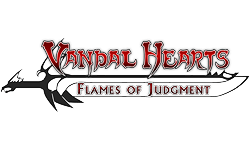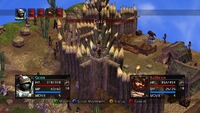|
|

|
PLATFORM
|
XBLA
|
BATTLE SYSTEM
|

|
INTERACTION
|

|
ORIGINALITY
|

|
STORY
|

|
MUSIC & SOUND
|

|
VISUALS
|

|
CHALLENGE
|
Moderate
|
COMPLETION TIME
|
Less than 20 Hours
|
|
OVERALL

|
+ Terrific battle system
+ Solid menus
+ Quaint story
- Odd story pacing near end
- Long load times
- Not newbie friendly
|
Click here for scoring definitions
|
|
|
In a time when the church raises orphans, after a recent war and a near-famine drove people to a peak of violence, trouble still brews under the thin veneer of society. Is there another war fated to take place, is God not paying attention, or is there something more sinister behind all this...? Leap into the world of Vandal Hearts: Flames of Judgment. Set before the previous two Vandal Hearts titles released on the PlayStation, there's no argument this title is a stellar TRPG. With a sensible levelling system, streamlined menus, and a fully developed story, there are only a few bumps in the road to overcome in the battle for God's blessing.
It is important to understand the basis of how characters advance before detailing the combat itself. Though infrequently used, the process isn't new: characters learn according to what they do. For example, equipping a bow and shooting enemies with it will upgrade a character's bow skill, ranged attack increases, and combat prowess in general goes up. The skill improves the amount of damage she does, the attack increases damage somewhat along with enlarging HP, and combat prowess increases overall battle effectiveness as well as enhancing HP and MP. Casting a spell increases the potency of that specific incantation and magic attack, which increases the character's MP pool. It sounds confusing at first, but after playing the very short tutorial and a map or two, players should have no trouble grasping these mechanics. All characters start out with a variety of weapon and spell proficiencies, though if the player prefers to slot them into other roles that is certainly possible. What is important to surviving the tougher battles is diversity; having too few ranged or magic casters will hamper a player's ability to effectively achieve their goals.
One of the many things Vandal Hearts does right is shaking up the usual TRPG grind. Many maps are comprised of multi-step battles, and "kill all/specific enemies" end up comprising only half of the nearly thirty goals. For example, in an early fight the player must hurl boulders at a bandit hideout to break down the gate and knock the bandit leader from his perch atop the wall's tower. Once that is complete, the new goal is to defeat the boss; whether the other bandits are defeated is entirely optional. Other interesting mechanics include finding the real opponent from a number of clones, as well as a special battle where defeated units join the player's side. With unusual and well-implemented scenarios like these, battles are very interesting indeed.
 Break that Gate!
Break that Gate!
|
|
Just like the previous games in the series, this Vandal Hearts features a tactical, grid-based combat system. One round consists of actions both allies and enemies make, including movement. Taking an action ends a turn, so the player must move if needed before attacking, casting a spell, or using an item; swapping weapons is not the end of a turn. The player will essentially always be outnumbered, so it is important to carefully consider each turn. Characters that are close together may trigger a team attack (which also has its own level), so staying grouped up is an important strategy not just for defence but for bonus attacks. Characters may carry two weapons into battle, and it is prudent for the player to practice with both weapons and/or magic. Due to the sheer amount of information the game requires the player to absorb and because of the constantly evolving combat goals, Vandal Hearts is not a good means of introducing new players to this genre.
Personal preference will in large part determine how appealing the game's visual style is, but it is obvious a great amount of care was poured in. Combat is on a three-quarter overhead field with fully developed 3D models. Conversation takes place with anime-style portraits for each character. Major plot cutscenes take a third style, using flat paperesque animation to enact past and present events alike. Some players may find the mishmash of styles to be awkward but each has been given considerable care and thought. The game's music is also quite good, and most importantly the battle music (arguably the most repeated piece in any tactical RPG) is both interesting and benign enough to not become tiresome or irritating.
How difficult a player will find Vandal Hearts will greatly depend upon prior knowledge of TRPGs, general strategic planning, and how aggressively each battle is approached. Those looking to place on the game's leaderboard will want to minimize the amount of rounds used during the game, raising the difficulty considerably. Those who wish to further challenge themselves may take up novelty runs, such as training all six characters using only bows. The typical player will find the game has a very average difficulty, and those struggling can revisit old locations to grind on easier enemies. The game isn't terribly long — fast players can likely finish in ten hours or so. One of the frustrating factors in the game is how annoyingly long load screens last, often taking thirty seconds to clear. It will not be unusual for players to take an equal amount of time with the multiple endings and plentiful secret maps to be found after the credits roll for the first time, however.
There's nothing to complain about script-wise in Vandal Hearts, which has a good mix of funny and serious moments. The interface is also well done, which is very important due to the sheer amount of information the player has access to and must rely upon to succeed in battle. Menus are all laid out clearly and players can easily access all the information needed about spell and combat levels as well as expanded storyline information. Handily, anything improved or new is marked with an exclamation mark so players can track down changes and additions easily.
 Outnumbered in Combat
Outnumbered in Combat
|
|
The game's story is simple: God punished the people for warring, and now a new war threatens to break out — will the wrath of God strike down again, or is there a more human reason for this war to both start and end? The story plays out well, but near the end suffers from some unusually rushed pacing through the two maps leading up to the finale. As maps prior to this often had two or three goals, the fact that the final maps eschew this option and negatively affect the pacing makes the ending feel somewhat awkward. With regards to originality, the game does an excellent job building upon today's TRPG standards, such as not only adding additional story in the menu but telling players to look there, which other games somehow forget to mention.
Vandal Hearts is an affirmation that a small company without gobs of funds can take a game premise and turn it into a true treasure. Though the game isn't terribly friendly to newcomers of the tactical subgenre, anyone who is familiar with strategic planning and thinking should have no problems diving right in and enjoying this title repeatedly. With multiple endings and achievements to unlock associated with them, there are many reasons to not only pick it up, but to keep playing long after the game has been completed once.
Review Archives
|









